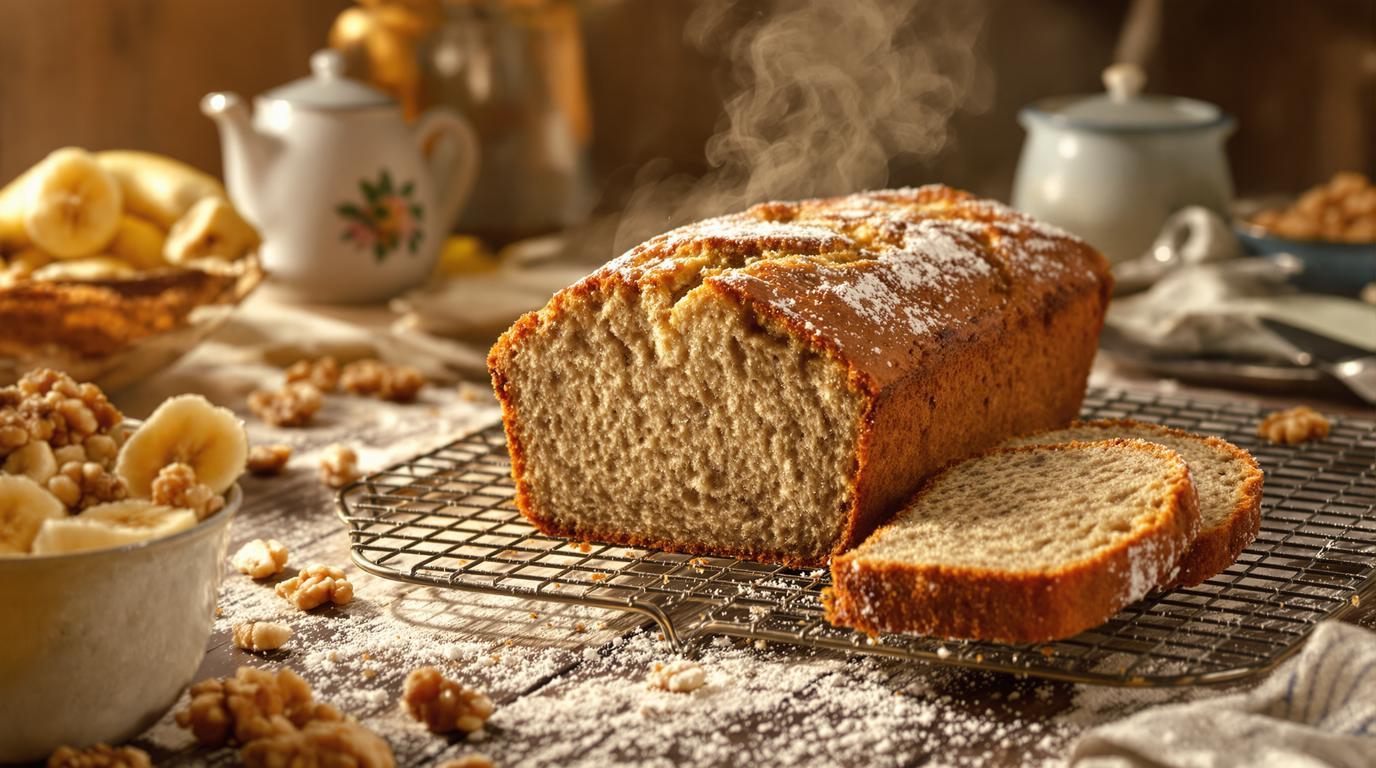There’s something magical about the scent of banana bread wafting through the kitchen—it’s like a time machine transporting me back to my grandmother’s farmhouse kitchen. Her recipe, perfected during the Great Depression when resourcefulness was essential, teaches us that the humblest ingredients often create the most profound comfort. The secret? Those overripe bananas sitting on your counter aren’t past their prime—they’re just reaching their full potential for baking magic. 🍌
The Story Behind Classic Banana Bread
Banana bread emerged during America’s Great Depression as a brilliant way to use fruit that would otherwise go to waste. My grandmother’s recipe came from those resourceful Southern kitchens where nothing was wasted and everything was transformed into something delicious. This recipe honors that tradition—simple ingredients combined with patience and care.
What makes this recipe special is its balance between moisture and structure. Many modern recipes compensate with excess sugar or butter, but this traditional approach lets the natural sweetness of truly ripe bananas shine. Those dark, spotted bananas aren’t just acceptable—they’re essential for authentic depth of flavor. 🌟
Essential Ingredients
For the batter:
• 2 cups (240g) all-purpose flour
• 1.5 teaspoons baking soda
• Pinch of salt
• 1 cup (200g) granulated sugar
• 1/2 cup (120ml) vegetable oil
• 2 large eggs, room temperature
• 1 teaspoon vanilla extract
• 1 1/3 cups (about 3-4) very ripe mashed bananas
• 1 cup (120g) chopped walnuts, divided
Chef’s Note: The bananas should be so ripe that they’re nearly black—this is where the complex flavor develops. If you need ripe bananas quickly, check out my guide to using overripe bananas for the best baking results.
Step-by-Step Instructions
1. Prepare your workspace – Preheat your oven to 350°F (175°C) and grease two 8×4-inch loaf pans. I prefer a light coating of oil rather than flour, which can create a gummy exterior.
2. Combine dry ingredients – In a medium bowl, whisk together flour, baking soda, and salt. This ensures even distribution of leavening agents—a step many home bakers overlook.
3. Mix wet ingredients – In a large bowl, beat sugar and oil together until well combined. Add eggs one at a time, incorporating completely before adding the next. Stir in vanilla and mashed bananas until blended but still textured.
4. Create your batter – Gently fold the dry ingredients into the wet mixture just until combined. Stop when you still see a few streaks of flour—overmixing is the most common mistake in quick breads, creating a dense, chewy texture instead of a tender crumb.
5. Add texture – Fold in 3/4 of the chopped walnuts, reserving the remainder for topping. If you’re not a walnut fan, try toasted pecans or even some dark chocolate chips like in my brownie recipe.
6. Bake with care – Divide batter between prepared pans, sprinkle with remaining nuts, and bake for 35-45 minutes. The banana bread is done when a knife inserted in the center comes out clean. If the top browns too quickly, loosely cover with foil for the last 10 minutes.
Chef’s Secret Techniques
For a beautiful presentation, use a spatula to create a shallow lengthwise groove in the batter before baking—this encourages the characteristic “split” on top of the loaf that professional bakers aim for.
Toast your walnuts in a dry skillet for 2-3 minutes before adding them to the batter. This simple step enhances their natural oils and creates a richer, more aromatic flavor profile that complements the sweet bananas perfectly.
If you want to experiment with international flavors, try adding a pinch of salt as they do in Vietnamese cuisine—it subtly enhances sweetness while balancing flavors.
Serving & Presentation Tips
Allow your banana bread to cool in the pans for exactly 10 minutes—no more, no less. This precise timing allows the structure to set while preventing condensation that leads to sogginess. Transfer to a wire rack to finish cooling completely.
For an elegant dessert presentation, warm a thick slice and top with a scoop of vanilla ice cream and a drizzle of caramel. For breakfast, try toasting a slice and adding a thin layer of cream cheese—the contrast of warm bread and cool, tangy spread is divine.
This classic pairs beautifully with sweet white wines like Moscato or Riesling, complementing the bread’s fruity notes. For a non-alcoholic option, a cup of cinnamon tea makes a wonderful accompaniment.
Every time I bake this banana bread, I’m reminded that true culinary magic often comes from simplicity and tradition. The ingredients are humble, but the result is extraordinarily comforting—a reminder that sometimes the most special recipes aren’t about exotic ingredients or complicated techniques, but about honoring the wisdom that’s been passed down through generations of caring hands. Whether you’re making this for a special brunch or just a simple afternoon treat, I hope it brings the same warmth to your home that my grandmother’s recipe has always brought to mine. 🏡💕
